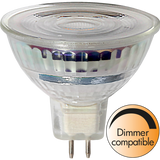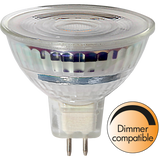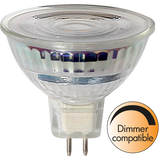STAR TRADING GU5.3 LED bulbs





star trading gu5.3 led bulbs range and formats
The classic Ø50 mm MR16 footprint with GU5.3 pins covers most fixed/tilt cans and compact gimbals. Power nodes typically 3.5/5/6.5/8 W, delivering ~350/500/650/800–900 lm depending on beam and CCT (2700/3000/3500/4000 K). Baseline CRI 80 is common; CRI 90 with healthy R9 is stocked for wood, food, fabrics, and skin tones. Operating window −20…+40 °C; keep Tc ≤ 85 °C in insulated ceilings. Pro lots target PF ≥ 0.90 (≥6–7 W), THD ≤ 15 %, and flicker discipline around PstLM ≤ 1.0, SVM ≤ 0.4 on approved dimmers.
star trading mr16 led lamps optics and beams
Two optical engines solve 95 % of briefs. TIR-lens variants in 10°/15°/24°/36° produce crisp edges and high centre-beam candlepower (CBCP); reflector-glass styles read “halogen” in heritage trims and run 24°/36°/60°. Size by CBCP at the working distance, not lumens alone: a 6.5 W 15° head can exceed 2 000 cd @ 1 m. Accessory rings accept honeycomb or softening films to tame near-field sparkle on glossy stone and lacquer.
star trading recessed lighting bulbs installation notes
These lamps are 12 V and like short, chunky secondaries. For small groups, LED-rated electronic transformers with low minimum load work; for long multi-head runs, a 12 V constant-voltage driver per circuit is steadier. Keep twin-lead legs short to preserve low-end dimming. Use T-rated lampholders (polymer T180 or ceramic T300) where trims run hot; front IP (e.g., IP44) is defined by the host downlight ring, not the lamp itself.
star trading directional spot lamps series and use-cases
- TIR Accent — 10°/15°/24°; highest CBCP; CRI 90 nodes for merchandise and timber.
- Refector Classic — 24°/36°/60°; halogen-like look; forgiving in direct view.
- Warm-Dim — 3000 → ~1800 K curve; lower peak lm by design but very convincing ambience.
- Short-Neck — reduced overall length for shallow heritage cans and tight gimbals.
Bins are held to ≤ 3 SDCM so replenishment lots don’t drift.
Electrical architecture and control (practical)
Most lamps accept AC/DC. Trailing-edge (RC) channels run quietest; leading-edge (RL) may buzz on tiny loads. Expect smooth ~5–100 % on narrow beams and ~10–100 % on floods when the plate load sits in the dimmer’s stable window. Surge ride-through is typically 1–2 kV (L-L); add upstream SPD where lifts/VFDs share the board.
Application map with working picks
- Vitrines/jewellery: 10–15°, 3000–3500 K, CRI 90; aim for 1 500–2 500 lx on the target plane.
- Tables/bars: 24°, 2700–3000 K with honeycomb in low ceilings to protect sightlines.
- Aisles/corridors: 36–60°, 3000/4000 K for calm pools and predictable uniformity
- Bathrooms/wash-adjacent: use closed-glass rings; lamp remains IP20
Construction details installers actually check
Die-cast or thermally-loaded polymer crowns move heat away from the board; Tc pads are marked for probe checks. Fronts are PMMA TIR or tempered glass with UV-stable seals. Overall length ~45–52 mm (verify on shallow trims). Through-wire downlight bodies keep control buses intact across rows when these spots mix with panels/linears.
In retail specs you’ll sometimes see star trading spotlight bulbs gu5.3 used as umbrella wording—mirror the phrase on the schedule, but size by beam/CBCP at distance so the look lands right the first time.
For estates moving off halogen, planners usually tag these as star trading low voltage led bulbs on the riser; publish transformer model/min-load and dimmer topology per area to avoid low-end shimmer during commissioning.
Straight swap programs often request star trading gu5.3 retrofit leds; lock five items on one line—beam (°) + lumen/CBCP at target + CCT/CRI + driver path (AC/DC or 12 V CV) + overall length—so cartons land site-ready.
Selection checklist for specifiers
- Beam and CBCP at the working distance (then choose wattage).
- Colour policy by zone: 2700 K dining, 3000 K public rooms, 3500/4000 K task; CRI/R9 where materials matter
- Dimming topology (RC/RL) and aggregate load per plate; avoid single 4–5 W channels.
- Electrical path: LED-rated transformer vs 12 V CV, secondary length/gauge, SPD need.
- Geometry/thermal: overall length vs can depth; holder T-class; airflow around the crown.
- Logistics: standardise one TIR and one reflector series per area to keep spares lean.